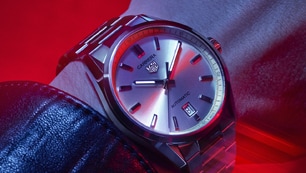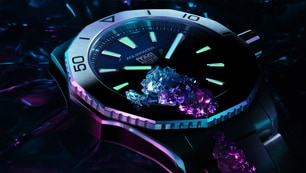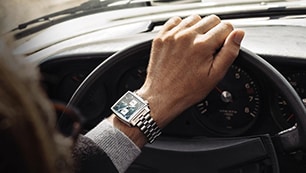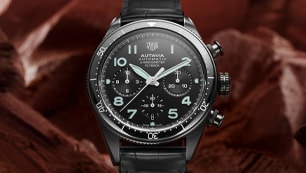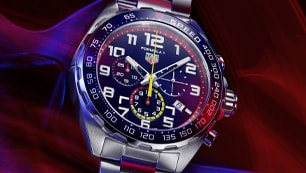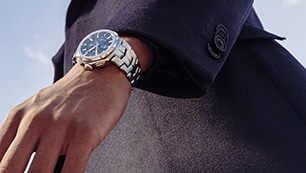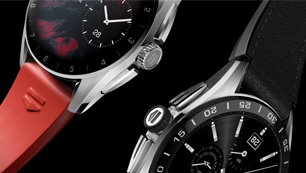Chapter I 1860 - 1887Strong Foundations
The company established by Edouard Heuer in 1860 would rely on two foundations – family leadership and technical innovation. These foundations served the company well, both in the early years and in the decades that would follow.
Scroll to Discover1860 - The First Heuer
At age 20, Edouard Heuer opened his watch making shop in Saint-Imier, producing pocket watches, mostly in silver.
1869 - The First Patent
In 1869, Edouard Heuer changed the course of watchmaking with his first patent, covering a crown-operated, keyless winding system.
1887 - The Perfected Chronograph
In 1887, Heuer introduced a patent to improve the “oscillating pinion.” This improvement allowed the chronograph to start and stop instantly with the use of a push-button.
Chapter II 1887 - 1933Precision on the World Stage
At the turn of the 20th century, innovations in industrial production, transportation, science and medicine brought demands for more precise timing. In athletics, demands for accurate, reliable timing gear became more critical, as competitors and world records might be separated by mere hundredths of a second.
Scroll to Discover1911 - Time of Trip
As travel by automobile and air took hold, Heuer designed an instrument to be installed on the dashboards of the new generation of vehicles.
1916 - Mikrograph and Microsplit
Disciplines as varied as sports timing, industrial production and artillery calculations demanded more precise stopwatches.
Chapter III 1933 - 1958Broader and Deeper
The era opened with Heuer having a catalog of stopwatches and pocket chronographs, but only a limited selection of wrist chronographs. In the next decades, Heuer vastly expanded the range of wrist chronographs, to become the world leader in these instruments.
Scroll to Discover1933 - The Dashboard Autavia
In 1933, Heuer introduced the “Autavia”, a name that would continue in its catalog for decades to come.
1949 - The Solunar
A colorful new watch was called the “Solunar”. Hunters, fishermen and sailors may derive important information by tracking the phase of the moon, as well as the time of high and low tides.
1957 - The Ring-Master
In 1957, Heuer introduced an entirely new type of stopwatch, with the owner inserting brightly-colored, interchangeable rings to time different events.
Chapter IV 1958 - 1969The Golden Age
1958 marked the dawn of a new era for Heuer. Jack Heuer became the fourth generation to manage the family company. The decade would see new chronograph models, innovating designs for legendary stopwatches and dashboard timers dominating the rally world.
Scroll to Discover1958 - The Fourth Generation Heuer
Jack Heuer formally joined Ed. Heuer & Co. S.A., as the fourth-generation leader of the family business.
1962 - The Tool for Adventure
The “Autavia” chronograph is Heuer’s first chronograph with a Collection name.
1963 - The Romance of Racing
In 1963, Heuer introduced the Heuer Carrera, the chronograph that captured the romance and danger of racing.
Chapter V 1969 - 1985The Colorful Era
Heuer introduced the world’s first automatic chronographs in 1969, with the Autavia, Heuer Carrera and Monaco models. Heuer quickly moved from the classic black and white of the 1960s to the vibrant colors and outrageous shapes of the 1970s.
Scroll to Discover1969 - Calibre 11: the First Automatic Chronographs
The joint venture led by Heuer would be the first to offer automatic chronographs in worldwide markets, with the Calibre 11 (Chronomatic) movement.
1969 - Monaco and McQueen
Three models were powered by Heuer’s first automatic movement, but it was the new Monaco that captured the world’s attention.
1971 - The Centigraph for Track Timing
Heuer’s Electronics Division developed the Centigraph, a timing system used by Ferrari racing team.
Chapter VI 1985 - 2004Rebirth and Modernity
Under the new ownership of Techniques d’Avant-Garde business group, TAG Heuer made the transition from a brand associated with mechanical chronographs to a company designing watches for the 21st century. Models developed in the 1980s became the mainstays of today’s TAG Heuer catalog.
Scroll to Discover1986 - The Formula One
TAG Heuer responded to the introduction of a new paradigm in the world of watches, with a revolutionary collection of its own: the TAG Heuer Formula 1.
1987 - Sports and Elegance
TAG Heuer soon moved upmarket, from its traditional dive watches to watches that would incorporate the most sophisticated designs.
1999 - LVMH Acquires TAG Heuer
In 1999, leading French luxury-goods group LVMH Moet Hennessy Louis Vuitton acquired TAG Heuer.
Chapter VII 2004 - 2015Pushing the Limits
To open the 21st century, TAG Heuer would develop entirely new approaches to the construction of watches and their movements. These innovations would provide record-breaking precision, in watches styled to reflect their leading-edge technologies.
Scroll to Discover2004 - The Monaco V4
The Monaco V4 Concept Watch introduced an entirely new approach to powering a mechanical watch, with construction that evokes a racing engine.
2010 - Calibre 1887 Movement
In 2010, TAG Heuer released its first in-house chronograph movement, the Calibre 1887.
Chapter VIII 2015 - CURRENTConnecting Past and Future
TAG Heuer leverages its rich portfolio of historic watches, by developing and incorporating today’s leading-edge technologies. Whether the enthusiast prefers a silicon chip, a tourbillon or a carbon hairspring, their watch connects TAG Heuer’s past and future.
Scroll to Discover2015 - The Connected Watch
In November 2015, TAG Heuer introduced the first Swiss luxury smartwatch, the TAG Heuer Connected watch.
2019 - Monaco 50th Anniversary
The mark the 50th anniversary of the Monaco, TAG Heuer offered a series of five limited edition models, each reflecting the style of a decade.
1860
1887
1887
1933
1933
1958
1958
1969
1969
1985
1985
2004
2004
2015
2015
CURRENT
TAG HEUER'SHISTORY
Since 1860, TAG Heuer has embodied avant-garde, precision and bold style, that have marked the world history of the watch industry. We invite you to explore our legacy, through our timepieces and innovations.
To enjoy the full experience,
turn on your speakers.

